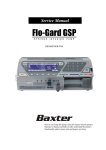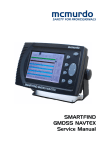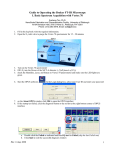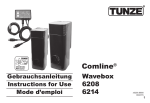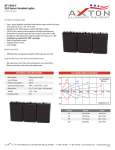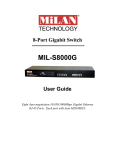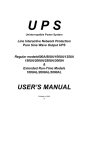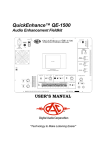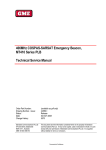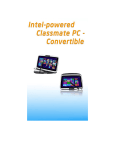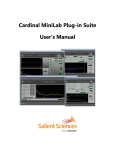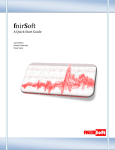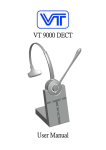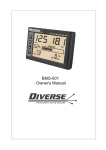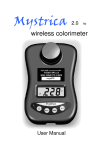Download Hardware User Manual - Comline Elektronik Elektrotechnik GmbH
Transcript
VERSION 1.0 COMLINE ELEKTRONIK ELEKTROTECHNIK GMBH Advanced Wiring Systems and Sensor Systems IRSphinx User Manual COMLINE ELEKTRONIK ELEKTROTECHNIK GMBH IRSphinx User Manual Manufacturer: Comline Elektronik Elektrotechnik GmbH Karl-Rapp-Str. 1 92442 Wackersdorf, Germany Phone +49943175650 • Fax +499431756525 www.comline-elektronik.de • [email protected] Document filename: IM_IRSphinx All rights reserved. No parts of this work may be reproduced in any form or by any means graphic, electronic, or mechanical, including photocopying, recording, taping, or information storage and retrieval systems - without the written permission of the publisher. Products that are referred to in this document may be either trademarks and/or registered trademarks of the respective owners. The publisher and the author make no claim to these trademarks. While every precaution has been taken in the preparation of this document, the publisher and the author assume no responsibility for errors or omissions, or for damages resulting from the use of information contained in this document or from the use of programs and source code that may accompany it. In no event shall the publisher and the author be liable for any loss of profit or any other commercial damage caused or alleged to have been caused directly or indirectly by this document. Specifications may change without prior notice. TABLE OF CONTENTS 1 2 3 4 5 Preface ............................................................................................................................... 2 1.1 Using this Guide .......................................................................................................... 2 1.2 Conventions ................................................................................................................. 2 1.3 Product Overview......................................................................................................... 3 Warnings and Safety Information ........................................................................................ 5 2.1 General Safety ............................................................................................................. 5 2.2 Warning Labels ............................................................................................................ 6 2.3 EMC Compliance ......................................................................................................... 6 2.4 ZnSe (Zinc Selenide) Window ...................................................................................... 6 2.5 LiPo Accumulator ......................................................................................................... 8 2.6 Special notes regarding the Use of the LiPo battery..................................................... 9 Unpacking and Installation .................................................................................................11 3.1 Package contents IRSphinx ........................................................................................11 3.2 Overview IRSphinx ATR .............................................................................................12 3.3 Overview IRSphinx Transmission ...............................................................................13 3.4 Inserting the IRSphinx spectrometer battery ...............................................................15 3.5 Connecting up the IRSphinx ATR ...............................................................................16 3.6 Switching on your IRSphinx ATR spectrometer ...........................................................17 3.7 Connecting up the IRSphinx Transmission .................................................................17 3.8 Sampling procedures for liquids and solids .................................................................18 3.9 Installing SphinxSuite ..................................................................................................19 Description of the Spectrometer Units ................................................................................20 4.1 IRSphinx ATR .............................................................................................................20 4.2 IRSphinx Transmission ...............................................................................................21 4.3 IRSphinx Accessories - cuvettes .................................................................................22 Routine Maintenance and Service .....................................................................................23 5.1 IRSphinx Maintenance Procedures .............................................................................23 5.2 Maintenance of the cuvette .........................................................................................23 5.3 Warranty Exclusions and Limitations ..........................................................................25 5.4 Troubleshooting ..........................................................................................................26 IRSphinx User Manual 1 Comline Elektronik Elektrotechnik GmbH 5.5 6 Service........................................................................................................................27 Appendices ........................................................................................................................28 1 PREFACE With the new developed IRSphinx MID-IR spectrometer a new chapter of IR spectroscopy is opened in the middle infrared spectral range. Due to the no-moving-parts design, applications even in harsh environmental conditions are made possible. The small size and power consumption stands out clearly from conventional IR spectrometers available on the market. IR spectroscopy is a powerful technique for measuring the concentration of organic molecules. The physical effect of infrared light absorption by molecules contained in the sample is measured. Each molecule absorbs light of a certain wavelength. The strength of absorption is a measure of the concentration of the particular molecule. The sensor is based on a spectral apparatus that is constructed with no-moving-parts, which makes it durable and virtually maintenance free. Meaningful parameters are calculated from the recorded spectra by a previously built calibration (chemometric model). In addition to portable systems for rapid on-site analysis, device models for use in the laboratory are available – as well as rugged field installations for inline operation. 1.1 USING THIS GUIDE This guide tells you how to install and maintain the IRSphinx system; We recommend that you use it as follows: 1. Reading Warnings and Safety Information in Chapter 2. 2. Follow the procedures in Unpacking and Installation in Chapter 3. 3. Read Description of the Spectrometer Units in Chapter 4, to learn about the spectrometer. 4. Read the first section of the Maintenance Chapter 5 to learn what maintenance is required. 1.2 CONVENTIONS Two terms, in the following standard formats, are also used to highlight special circumstances and warnings. IRSphinx User Manual 2 Comline Elektronik Elektrotechnik GmbH We use the term WARNING to inform you about situations that could result in personal injury to yourself or other persons. Details about these circumstances are in a box like this one. We use the term CAUTION to inform you about situations that could result in serious damage of the instrument or other equipment. Details about these circumstances are in a box like this one. 1.3 PRODUCT OVERVIEW The IRSphinx spectrometers are available in different configurations. In general the spectrometers are classified into the types: Lab, Portable and Industrial. The sample interface can be chosen between Transmission and ATR, the spectral range between 2.5-5µm (20004000cm-1) and 5.5-11µm (1800-900cm-1) and the material of the cuvette windows and the ATR crystal can be chosen between ZnSe (zinc selenide) and ZnS (zinc sulfide). Additional accessories like an ATR flow through plate or a gas-cell is available. All Transmission mode spectrometers feature two additional bandpass sensors which can be changed customer specific. Article Number Product Name IRSphinx ATR mode spectrometers LVF ATR Crystal 919100-00 IRSphinx ATR Lab 2,5-5µm ZnSe 919101-00 IRSphinx ATR Lab 2,5-5µm ZnS 919200-00 IRSphinx ATR Lab 5,5-11µm ZnSe 919201-00 IRSphinx ATR Lab 5,5-11µm ZnS 918100-00 IRSphinx ATR Industrial 2,5-5µm ZnSe 918101-00 IRSphinx ATR Industrial 2,5-5µm ZnS 918200-00 IRSphinx ATR Industrial 5,5-11µm ZnSe 918201-00 IRSphinx ATR Industrial 5,5-11µm ZnS 917100-00 IRSphinx ATR Portable 2,5-5µm ZnSe 917101-00 IRSphinx ATR Portable 2,5-5µm ZnS 917200-00 IRSphinx ATR Portable 5,5-11µm ZnSe 917201-00 IRSphinx ATR Portable 5,5-11µm ZnS IRSphinx Transmission mode spectrometers Bandpass config 909100-00 IRSphinx Transmission Lab incl. cuvette ALU 2,5-5µm 3.09µm / 4.64µm 909200-00 IRSphinx Transmission Lab incl. cuvette ALU 5,5-11µm 3.09µm / 4.64µm 908100-00 IRSphinx Transmission Industrial incl. cuvette Stainless 2,5-5µm 3.09µm / 4.64µm 908200-00 IRSphinx Transmission Industrial incl. cuvette Stainless 5,5-11µm 3.09µm / 4.64µm IRSphinx User Manual 3 Comline Elektronik Elektrotechnik GmbH 906100-00 IRSphinx Transmission Fieldkit incl. cuvette Stainless 2,5-5µm 3.09µm / 4.64µm 906200-00 IRSphinx Transmission Fieldkit incl. cuvette Stainless 5,5-11µm 3.09µm / 4.64µm 907100-00 IRSphinx Transmission Portable incl. cuvette ALU 2,5-5µm 3.09µm / 4.64µm 907200-00 IRSphinx Transmission Portable incl. cuvette ALU 5,5-11µm 3.09µm / 4.64µm IRSphinx Accessoire 90901-00 Cuvette Alu ZnSe 90902-00 Cuvette Stainless Steel ZnSe+fluid channels SphinxSuite Software 941100-00 SphinxSuite Basic (additional license) 941100-01 SphinxSuite Option A (modulation frequency) 941100-02 SphinxSuite Automation 941100-03 SphinxSuite Chemometrics 941100-04 SphinxSuite Prediciton 941100-05 SphinxSuite Standalone IRSphinx User Manual 4 Comline Elektronik Elektrotechnik GmbH 2 WARNINGS AND SAFETY INFORMATION 2.1 GENERAL SAFETY The IRSphinx Spectrometers has been designed and tested in accordance with the safety requirements of the International Electrotechnical Commisions (IEC). The spectrometer conforms to IEC publication 61010-1 (Safety requirements for electrical equipment for measurement, control, and laboratory use). If the instrument is used in a manner not specified by the manufacturer, the protection provided by the instrument may be impaired. Only use the IRSphinx under following conditions: Temperature: 0°C to 50°C Humidity: 75% maximum (non-condensing) Whenever it is likely that the IRSphinx is unsafe make it inoperative. The IRSphinx may be unsafe if it: Shows visible damage Fails to perform the intended measurement Has been subjected to prolonged storage in unfavorable conditions Has been subjected to severe transport stresses If the equipment is used in a manner not specified herein the protection provided by the equipment may be impaired The IRSphinx contains a pulsed hot source and contact with flammable vapors may cause an explosion. When working with flammable solvents or samples make sure that no flammable vapor is entering the system. If there is any possibility that they have entered the interior (by coming into contact with the gasket of the ATR sample stage for example) the the instrument must be switched off immediately and disconnected from the power supply and battery. Flammable solvents or samples should not be stored on or near the instrument. Handling of such materials during preparation should be performed in a safe area away from the instrument such as a fume cabinet. IRSphinx User Manual 5 Comline Elektronik Elektrotechnik GmbH Some chemicals used with this instrument may be hazardous or may become hazardous after completion of an analysis. The responsible body (for example, the Laboratory Manager) must take the necessary precautions to make sure that the surrounding workplace is safe and that the instrument operators are not exposed to hazardous levels of toxic substances (chemical or biological) . Venting for fumes and disposal of waste must be in accordance with all national, state and local health and safety regulations and laws. 2.2 WARNING LABELS Warning signs on the instrument Caution (refer to accompanying documents) 2.3 EMC COMPLIANCE The IRSphinx system has been designed and tested to meet the requirements of the EC Directive 89/336/EEC. The IRSphinx complies with the EMC standard EN61326-1:2013 (EMC standard for electrical equipment for measurement, control and laboratory use), EN 301 489-01; V1.9.2 (portable version) and EN 61000-3-3:2013 (industrial version). 2.4 ZNSE (ZINC SELENIDE) WINDOW During routine use of the IRSphinx the ZnSe windows in the flowcell or ATR unit present no hazard, but: IRSphinx User Manual DO wear protective gloves when handling the windows. DO NOT use acids to wash the windows because they react to emit H 2Se, which is very toxic and irritating. Avoid contact of the windows with oxidizers. ZnSe is highly toxic by ingestion 6 Comline Elektronik Elektrotechnik GmbH 2.4.1 Cleaning the ZnSe Crystal Avoid a contact of the window with oxidizers or acids. ZnSe can be cleaned in pure dry acetone or methanol using a soft, lint-free cloth and drying in a current of warm air so that there is no possibility of condensation forming on the window. Other suitable solvents are petroleum ether and hexane. The windows may also be cleaned in some commercial laboratory detergents, but they must be neutral. Alkaline solutions will slightly etch the surface, and acids will severely attack the material. A final rinse in distilled water and drying in a current of warm air is recommended. Hazard Class UN Number CAS Number 2.4.2 Physical Data Description Melting point Boiling point Specific gravity Solubility in water Vapor pressure Vapor density 2.4.3 6.1 2811 1315-09-9 Yellow crystal 1525°C Not applicable Not applicable Immiscible or insoluble Not applicable Not applicable Fire and Explosion Hazard May evolve toxic fumes in a fire Flash point Explosive limits Auto-ignition temperature Fire-fightin measures 2.4.4 Not applicable Not applicable Not applicable Use extinguisher suitable for surrounding fire Health Hazard In contact with gastric juices, very toxic and irritating H2Se is evolved. Chronic effects: can cause dermatistic and digestive disturbances. Garlic odor of breath is a common symptom. May cause pallor, nervousness and depression. Toxicity data Carciogenicity Mutagenicity/ Teratogenicity Exposure limits OES, mg/m³ IRSphinx User Manual TLV (soluble compounds) 0.2 mg/m³ as for selenium compounds; LD 50 unknown No evidence of caciogenic properties No evidence of mutagenic or teratogenic effects 0.2 Se (Long-ter, 8 hour TWA). 7 Comline Elektronik Elektrotechnik GmbH 2.4.5 First Aid Affected Area Eyes Effect of exposure Harmfull Lungs Irritates Skin Irritates 2.4.6 Reactive Hazards Stability Reaction with water Decomposition products Other known hazards Avoid contact with 2.4.7 acute Emergency First Aid Irrigate thoroughly with water for at least 10 minutes; OBTAIN MEDICAL ATTENTION if discomfort persists Remove from exposure, rest and keep warm; OBTAIN MEDICAL ATTENTION in severe cases Wash thoroughly with soap and water; OBTAIN MEDICAL ATTENTION if discomfort persists If ZnSe is swallowed or ingested, wash out mouth thoroughly with water; OBTAIN MEDICAL ATTENTION Stable May emit hydrogen selenide (H2Se) Highly toxic fumes. Decomposition results from extreme heat temperatures greater than 400°C especially in a oxidizing atmosphere Reacts with acids to give highly toxic hydrogen selenide (H 2Se) Water (no) Acids (yes) Bases (no) Oxidizers (yes) Combustibles (no) Storage and Handling Special requirements Wear protective gloves when handling the crystal 2.5 LIPO ACCUMULATOR Lithium-Polymer (abbreviation: LiPo) batteries require particularly careful handling. This applies to charging and discharging techniques, and also to storage and other aspects of general handling. Special measures must be observed, and these are outlined below. Mishandling these batteries may lead to explosions, fire, smoke and a risk of poisoning. In addition to these hazards ignoring our instructions and warnings will result in loss of battery performance and other problems. The capacity of a LiPo battery declines every time you charge or discharge it. Storing these batteries at excessively high or low temperatures may also cause a gradual reduction in capacity. IRSphinx User Manual 8 Comline Elektronik Elektrotechnik GmbH 2.6 SPECIAL NOTES REGARDING THE USE OF THE LIPO BATTERY 2.6.1 General warning notes LiPo batteries must not be thrown in a fire or incinerated. LiPo cells must not be allowed to come into contact with fluids such as water, salt water or drinks, even for a very short period. Avoid all contact with liquids of any type. Batteries must not be placed in a microwave oven or subjected to pressure. This may result in smoke and fire or even worse. Never dismantle a LiPo battery. Dismantling a pack may cause internal short-circuits, with the possible results of gassing, fire, explosion and other problems. LiPo batteries contain toxic electrolytes and electrolyte vapours which are damaging to health. Take great care to avoid direct contact with electrolyte. If electrolyte contacts your skin, eyes or any other body part, immediately wash it off using plenty of clean water, then consult a doctor. Never short-circuit these batteries. Shorting the terminals allows a very high current to flow, and this heats up the cell. This in turn may lead to a loss of electrolyte, gassing (venting of gas) or even an explosion. When handling the LiPo battery keep them well away from conductive objects and surfaces to avoid the danger of a short-circuit. The permissible range of temperature during the charging and storing of LiPo batteries is from 0 – 50° C. Storing: LiPo cells should be stored with a charged capacity of 10 – 20 %. Do absolutely avoid short-circuits. Permanent short-circuits cause a destruction of the battery, high temperatures and self-inflammation may be the consequence. IRSphinx User Manual 9 Comline Elektronik Elektrotechnik GmbH 2.6.2 Mechanical shock: LiPo batteries are not as mechanically robust as metal-cased cells, and for this reason you must avoid subjecting them to mechanical shocks such as dropping, hitting, bending, cutting, scoring, deforming or drilling into the laminate film. Never bend or twist the LiPo battery, and do not exert pressure on the battery or its connections. 2.6.3 Charging the LiPo bttery pack Charging of the LiPo battery pack is only allowed in the system with its appropriate Battery management unit. Any manipulation of the charger or of the charging lead may cause serious damages. The battery must be placed on a non-flammable, heat resistant and non-conductive surface directly inside the battery compartment of the system. Keep inflammable and volatile materials well away from the charging area. Batteries must not be left on charge unsupervised. 2.6.4 Mechanical strength of the case film: The aluminum laminate film which encloses the cells is easily damaged by sharp objects such as pins, knives, nails or similar: If the film is damaged, the battery is useless and has to be removed from the system immediately. If the pack were to be short-circuited, it could burst into flames. Temperatures above 70°C may also damage the case and cause leaks; this will result in loss of electrolyte, the battery gets useless and must be disposed of. 2.6.5 Handling the battery terminals: The terminals of LiPo cells are not as robust as those of other batteries; this applies in particular to the aluminum + terminal. Please note that the terminals can easily break off. Due to the heat transfer it is not possible to solder to the aluminum terminals. The terminals are fitted in the battery compartment without applying strain to them. 2.6.6 Replacing LiPo battery pack: The LiPo battery pack of the IRSphinx spectrometer may only be replaced by original spare parts from the manufacturer or a certified distributor. 2.6.7 Re-using damaged cells: Damaged cells must never be re-used. Indications of damage include broken housings, distortion of battery cells, escaping electrolyte or a smell of electrolyte. If your LiPo battery exhibits any of these problems it must not be used again. Damaged or exhausted cells constitute toxic waste and must be disposed of in the appropriate manner. IRSphinx User Manual 10 Comline Elektronik Elektrotechnik GmbH 3 UNPACKING AND INSTALLATION This user guide describes how physically set up and connect to your IRSphinx spectrometer and its standard sampling procedure. For details of how to use the software SphinxSuite please refer to SphinxSuite User Manual. 3.1 PACKAGE CONTENTS IRSPHINX The IRSphinx spectrometer is shipped with the following components. IRSphinx spectrometer with LiPo Battery (1) Power adapter (2) Ethernet Cable (3) USB/Power interface cable (4) USB A/B cable (5) License, User Manuals and Safety Documentation 2 1 5 3 IRSphinx User Manual 11 4 Comline Elektronik Elektrotechnik GmbH 3.2 OVERVIEW IRSPHINX ATR Sample Plate Sample Well ATR Crystal Status Indicator On/Off Indicator Charging Indicator IRSphinx IRSphinxTransmission Lab/Portable Ethernet Socket On/Off Button Power/USB Socket IRSphinx User Manual 12 Comline Elektronik Elektrotechnik GmbH M3 Thread for permanent installation 3.3 OVERVIEW IRSPHINX TRANSMISSION Cuvette Extension Port IRSphinx User Manual 13 Comline Elektronik Elektrotechnik GmbH Power connector CAN bus connector Ethernet USB IRSphinx User Manual 14 Comline Elektronik Elektrotechnik GmbH 3.4 INSERTING THE IRSPHINX SPECTROMETER BATTERY Due to shipping regulations the LiPo battery comes within the battery compartment and is unconnected. Never ship the spectrometer with connected LiPo battery. Prior to using your spectrometer you must ensure that its battery is connected: 1. Remove the 4 screws highlighted orange and remove the battery lid Battery Lid 2. Place your battery in the battery compartment and insert its connector into the port highlighted in red. Battery Compartment 3. Replace the battery lid and all screws that were removed. IRSphinx User Manual 15 Comline Elektronik Elektrotechnik GmbH 3.5 CONNECTING UP THE IRSPHINX ATR You can connect to your IRSphinx spectrometer over USB, Ethernet (Lab, Industrial) and with the portable versions over Bluetooth. The following diagram shows how to connect your spectrometer to a power supply, USB and Ethernet. Please note the diagram is merely illustrative and there is no need to connect to USB and Ethernet simultaneously. Provided the battery is charged, there is no requirement to use wires when using Bluetooth. The spectrometer can be used over a standard TCP/IP network. For details please refer to the SphinxSuite Manual. USB/Power Interface Cable 5V Power Supply USB A/B Cable ATR Spectrometer Windows Computer Ethernet Cable When you run a wired connection please make sure that you connect the spectrometer as follows: 1. Connect the 5V power supply 2. Turn it on 3. Then connect the USB cable to your PC When your spectrometer is connected to USB/5V power, the battery status indicator will glow orange when the battery is charging or green if it’s fully charged. IRSphinx User Manual 16 Comline Elektronik Elektrotechnik GmbH 3.6 SWITCHING ON YOUR IRSPHINX ATR SPECTROMETER Press the On/Off press button to turn your spectrometer on or off. When the spectrometer is on the On/Off indicator on the front of the system will flash blue, otherwise it will remain unlit. The status indicator will change colour depending on the operation state of the spectrometer. While disconnected from SphinxSuite it will glow solid green, otherwise it will glow solid amber. Whilst in the process of recording a spectrum, it will alternately flash green and orange. Please refer to the SphinxSuite manual for details of how to connect to your spectrometer. 3.7 CONNECTING UP THE IRSPHINX TRANSMISSION You can connect to your IRSphinx Transmission spectrometer over USB and Ethernet. When your spectrometer is connected to the 12V power supply it starts automatically. You can then connect over USB or Ethernet to the device. Please refer to the SphinxSuite manual for details of how to connect to your spectrometer. IRSphinx User Manual 17 Comline Elektronik Elektrotechnik GmbH 3.8 SAMPLING PROCEDURES FOR LIQUIDS AND SOLIDS Sampling an Infrared spectrum contains always of the following steps and changes slightly between Transmission and ATR mode readings. 3.8.1 IRSphinx Transmission modes spectrometers: 1. Turn on the spectrometer and start “Live View” to bring the spectrometer into operation temperature. The more stable the temperature of the better the taken spectra. 2. The background measurement always is taken without cuvette in the optical path. 3. Make sure that the optical windows over the light sources and the dispersive element are cleaned with a lint free tissue and take care not to scratch it. 4. Adjust the scan count for the Background to 400 or higher to achieve a noise minimized Background reading. The more time you invest here the better the results get. 5. When the spectrometer reached its operation temperature take a Background measurement. 6. Adjust the cuvette spacer thickness to your sample requirements (see Chapter 5.2 ) 7. Then place the cuvette into the optical path and fit it with both screws. To gain optimal repeatability make sure that the cuvette windows are cleaned with a lint free tissue and take care not to scratch it. The cuvette needs to be always in the same position so take care that it is screwed in exactly. 8. Fill the cuvette with the liquid sample and take care that no particles are flushed into the cuvette and no air bubbles stay in the optical path. 9. Take a sample reading. Here again, the higher the scan count the better the results at the end. 10. Flush the cuvette with an appropriate solvent 11. Take a new Background reading as often as the ambient temperature change requires this. IRSphinx User Manual 18 Comline Elektronik Elektrotechnik GmbH 3.8.2 IRSphinx ATR modes spectrometers: 1. Turn on the spectrometer and start “Live View” to bring the spectrometer into operation temperature. The more stable the temperature of the better the taken spectra. 2. The Background measurement always is taken without a sample on the ATR crystal. 3. Make sure that the ATR crystal is cleaned with a lint free tissue and take care not to scratch it. 4. Adjust the scan count for the Background to 400 or higher to achieve a noise minimized Background reading. The more time you invest here the better the results get. 5. When the spectrometer reached its operation temperature take a Background measurement. 6. Place a sample on the ATR crystal and be careful to cover the full crystal and to be free of air bubbles. 7. Take a sample reading. Here again, the higher the scan count the better the results at the end. 8. Clean the ATR with an appropriate solvent and a lint free tissue. 9. Take a new Background reading as often as the ambient temperature change requires this. 3.9 INSTALLING SPHINXSUITE 3.9.1 PC Hardware Requirements We recommend a hardware configuration with the following minimum requirements: Windows XP or Windows 7 (32 or 64bit) Processor: Intel Atom Z530 or higher 200 MB RAM At least 300 MB of Hard Disk Space (Run-Time included) RJ45 port for communication over Ethernet USB 2.0 port or higher for communication over USB (full and low speed) Bluetooth Adapter for communication over Bluetooth (for availability refer to the technical specification of your device) 3.9.2 Software Installation Please refer to the included SphinxSuite software manual. IRSphinx User Manual 19 Comline Elektronik Elektrotechnik GmbH 4 DESCRIPTION OF THE SPECTROMETER UNITS 4.1 IRSPHINX ATR Type Spectral range ATR Crystal Material ATR Frame Material Spectrometer Housing Material ATR Surface area Number of Sample Reflections Illumination Source Source Lifetime Dispersing Element Detector Pixel Size/Pitch Pixel to pixel wavelength interval Spectral Bandwidth (FWHM) Analogue to Digital Converter Dynamic Range (max) Signal to noise ratio Measurement time (typical) Operating Environment Storage environment Dimensions Battery Power Requirement Standalone operation Thermal Stablisation Interface Weight IRSphinx User Manual Lab Portable 2.5-5µm 5.5-11µm 2.5-5µm 5.5-11µm ZnS ZnSe ZnS ZnSe ZnS ZnSe ZnS ZnSe Grade 1.4401 stainless steel Anodised aluminium 17 x 27 mm 9 Electrically modulated MEMS emitter >5000 Hrs of continuous measurement Linear variable filter (LVF) 128-pixel uncooled pyroelectric array 60 x 500 µm/ 100 µm 43.3 nm <2% of centre wavelength 16-bit 5600:1 ~425:1 (2σ) using a 1 minute integration time ~30 seconds (N=200) 0 - 50°C non-condensing 0 - 60°C non-condensing L x W x H / 165 x 74 x 35 mm Lithium polymer (LiPo) – 4.8 Wh 5 Volt DC, 4W 5 Volt DC, 4W No No No No USB, Ethernet USB, Ethernet, Bluetooth 700g 710g 20 Industrial 2.5-5µm ZnS ZnSe 5.5-11µm ZnS ZnSe 5 Volt DC, 6W Yes Yes USB, Ethernet, CANopen 750g Comline Elektronik Elektrotechnik GmbH 4.2 IRSPHINX TRANSMISSION Type Spectral range Cuvette Spectrometer Housing Material ATR Surface area Number of Sample Reflections Illumination Source Source Lifetime Dispersing Element Detector Pixel Size/Pitch Pixel to pixel wavelength interval Spectral Bandwidth (FWHM) Analogue to Digital Converter Dynamic Range (max) Signal to noise ratio Measurement time (typical) Operating Environment Storage environment Dimensions Battery Power Requirement Standalone operation Thermal Stablisation Interface Weight IRSphinx User Manual Lab Portable 2.5-5µm 5.5-11µm 2.5-5µm 5.5-11µm aluminum aluminum Anodised aluminium 17 x 27 mm 9 Electrically modulated MEMS emitter >5000 Hrs of continuous measurement Linear variable filter (LVF) 128-pixel uncooled pyroelectric array 60 x 500 µm/ 100 µm 43.3 nm <2% of centre wavelength 16-bit 5600:1 ~425:1 (2σ) using a 1 minute integration time ~30 seconds (N=200) 0 - 50°C non-condensing 0 - 60°C non-condensing L x W x H / 165 x 74 x 35 mm No LiPo accu 12 Volt DC, 4W 5 Volt DC, 4W No No No No USB, Ethernet USB, Ethernet, Bluetooth 430g 460g 21 Industrial 2.5-5µm 5.5-11µm Stainless steel + fluid channels No 12 Volt DC, 6W Yes Yes USB, Ethernet, CANopen 460g Comline Elektronik Elektrotechnik GmbH 4.3 IRSPHINX ACCESSORIES - CUVETTES Type Article number Application Dimensions Open aperture Mounting holes Weight Pressure Housing Windows Gasket Spacer Fitting Spare parts Cuvette Alu 90901-00 Demountable standard cell for easy cleaning, for use in IRSphinx Transmission spectrometers H x W x D / 20 x 60 x 50 mm + fitting W x D / 19 x 11 mm M3 185g max. 5bar Aluminum – anodized ZnSe – Zincselenide Viton PTFE, 100 µm (typical) / 25 µm (on request) G1/8“, 4mm quick fitting coupling Window kit, gasket kit, spacer kit Type Article number Application Dimensions Open aperture Mounting holes Weight Pressure Housing Windows Gasket Spacer Fitting Spare parts Cuvette Stainless steel 90902-00 Demountable heavy duty cell for easy cleaning, for use in IRSphinx Transmission spectrometers H x W x D / 20 x 60 x 50 mm + fitting W x D / 19 x 11 mm M3 385g max. 15bar Stainless steel – 1.4301 / AISI 304 ZnSe – Zincselenide with milled in fluid channels Viton PTFE, 100 µm (typical) / 25 µm (on request) G1/8“,6mm SwageLok Window kit, gasket kit, spacer kit IRSphinx User Manual 22 Comline Elektronik Elektrotechnik GmbH 5 ROUTINE MAINTENANCE AND SERVICE 5.1 IRSPHINX MAINTENANCE PROCEDURES The IRSphinx was designed to be largely maintenance-free. However, some modules are subject to normal wear like the lightsource, the cuvette windows or ATR crystal. These modules can be serviced by sending it back to the manufacturer or by a service technician on site. 5.2 MAINTENANCE OF THE CUVETTE In normal use of the IRSphinx Transmission ensure that the cuvette is routinely kept clean and free of contaminants. Additionally we recommend that you regularly flush the system with a solvent to avoid the build up of contaminants. The cuvette can be fully disassembled to clean it or to adjust the spacer thickness. Screws Front of cuvette PTFE compression ring Viton O-rings Front ZnSe window PTFE spacer Back ZnSe window Fitting PTFE gasket Viton O-ring Back of cuvette IRSphinx User Manual 23 Comline Elektronik Elektrotechnik GmbH Handling instructions: Tighten crosswise symmetrically in low steps to avoid breaking the windows. Upper and lower housing will be separated about 200µm! Use a torque screwdriver that covers the range from 10-30cNm. Clean windows with soft lint tissue to avoid scratches Make sure the sealings are in right position before tighten the cuvette Make sure the spacers and PTFE gaskets are in right position and don’t block the lightpath The pathlength of the cuvette has to be recalculated after dismantling the cell. Failing to carry out this procedure will affect the results of the obtained spectra due to the BeerLambert’s Law. Do not use acid to clean the windows, as toxic fumes will be given off. Wear gloves when dismantling the cuvette as the ZnSe windows are toxic. Handle the windows carefully in order not to break them. The windows are brittle and easily broken. Be careful that you do not tighten the screws holding the cuvette together too tightly. An unsymmetrical tightening of the windows will lead to a breaking. We recommend that you use a torque screwdriver to tighten the screws. When cleaning the windows use a lint free tissue and take care not to scratch it. A strong force applied on the ATR crystal may lead to breaking. Strong thermal gradients may lead to a breaking of the ATR or cuvette crystal. When storing it under cold climate conditions bring it slowly into operation conditions before starting it. IRSphinx User Manual 24 Comline Elektronik Elektrotechnik GmbH 5.3 WARRANTY EXCLUSIONS AND LIMITATIONS The following consumable items are excluded from the warranty agreement. ATR crystal Cuvette windows Light sources LiPo battery Any attempts to perform installation or maintenance operations that are not detailed in this manual are at the user’s own risk. If a user-attempted service results in a visit by a Comline Service Engineer, the visit will not be covered by the instrument warranty. Warranty is excluded when the seal on the bottom of the instrument is damaged. Damage caused by the following is not covered by warranty: Failure to flush or clean the system adequately after use. Failure to observe the precautions described in this manual. Failure which resulted after flooding liquids into the system. Failure which resulted after a drop of the system. IRSphinx User Manual 25 Comline Elektronik Elektrotechnik GmbH 5.4 TROUBLESHOOTING Problem The system shows significant lower SNR than usual Possible cause The battery isn’t plugged to the system Corrective action Plug the battery The battery shows charging status a Charge the battery One or yielded emitters more light low The ATR or cuvette window is scratched heavily The ATR or cuvette window is broken Air bubbles in the sample Spectrometer shuts off after 6 hours IRSphinx User Manual Strong soot contamination permanently incorporated the crystal structure weakens the IR Connections of the cuvette loose or leaking has into and Contact the service to replace the light emitters Contact the service to the ATR or to order new windows Contact the service to the ATR or to order new windows Contact the service to the ATR or to order new windows replace cuvette replace cuvette replace cuvette are Check all the connections and tighten them The screws in the cuvette are loose Tighten the screws to correct torque Bubbles adhere to the ATR crystal Release the air bubbles from the crystal by gently stir with a spatula. Make sure that no air is left on the crystal First plug the spectrometer to the grid then plug it to the USB port. You wired a power limited USB port before plugging the spectrometer to the grid. 26 Comline Elektronik Elektrotechnik GmbH 5.5 SERVICE To service the instrument please contact the manufacturer: Comline Elektronik Elektrotechnik GmbH Karl-Rapp-Str. 1 92442 Wackersdorf, Germany Phone +49 (0) 9431 7565-0 Fax: +49 (0) 9431 7565-25 Website: www.comline-elektronik.de Email: [email protected] IRSphinx User Manual 27 Comline Elektronik Elektrotechnik GmbH 6 APPENDICES Other documents that are delivered with the device: 1. 2. 3. 4. 5. Software Manual SphinxSuite License certificate SphinxSuite Safety Datasheet LiPo battery Safety Datasheet ZnSe Test datasheet IRSphinx User Manual 28 Comline Elektronik Elektrotechnik GmbH






























